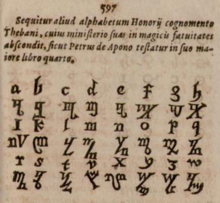Theban alphabet
The Theban alphabet is a writing system, in particular a substitution cipher of the Latin alphabet, used by early modern occultists and popular in the Wicca movement.
| Theban | |
|---|---|
 | |
| Type | Alphabet
|
| Creator | uncertain |
Time period | 16C–present |
Parent systems | |
Publication history
It was first published in Johannes Trithemius's Polygraphia (1518) in which it was attributed to Honorius of Thebes "as Pietro d'Abano testifies in his greater fourth book". However, it is not known to be extant in any of the known writings attributed to D'Abano (1250-1316). Trithemius' student Heinrich Cornelius Agrippa (1486–1535) included it in his De Occulta Philosophia (Book III, chap. 29, 1531).[1] It is also not known to be found in any manuscripts of the writings of Honorius of Thebes (i.e. Liber Iuratus Honorii or The Sworn Book of Honorius) with the exception of the composite manuscript found in London, British Library Manuscript Sloane 3853, which however openly identifies Agrippa as its source.
Uses and correlations
It is also known as the Honorian alphabet or the Runes of Honorius after the legendary magus (Theban is not, however, a runic alphabet) or the witches' alphabet due to its use in modern Wicca and other forms of witchcraft as one of many substitution ciphers to hide magical writings such as the contents of a Book of Shadows from prying eyes. The Theban alphabet bears little resemblance to other alphabets and has not been found in any previous publications prior that of Trithemius.
There is one-to-one correspondence between Theban and the letters in the old Latin alphabet. The modern characters J, U, and W are not represented and in modern usage these are transliterated using the Theban characters for I, V, and VV. Theban letters only exist in a single case. This suggests an origin for Theban as a cipher calqued on Latin, along with the various alphabets described by Trithemius and Agrippa, based on either Latin or Hebrew.
Eric S. Raymond, an American software developer and author, has created a draft proposal for adding the Theban alphabet to the Universal Coded Character Set/Unicode.[2]
In popular culture
- Theban alphabet is used in the album art of Ozzy Osbourne's Diary of a Madman (1981).[3][4]
- Theban is seen in the anime Hellsing Ultimate, written onto the vampire Alucard's glove.
- Theban is also seen in the 93rd chapter of the manga Black Butler, referred to by Sebastian Michaelis as "the Theban script of witches".
- Theban is used in Kieron Gillen's Phonogram as a language used by phonomancers to do music rituals. Also used as a secret code for phonomancers.
- Theban alphabet was used by the band My Chemical Romance in a post on their instagram[5]
Characters
 |  |  |  |  |  |
| A | B | C | D | E | F |
 |  |  |  |  |  |
| G | H | I / J | K | L | M |
 |  |  |  |  |  |
| N | O | P | Q | R | S |
 |  |  |  |  |  |
| T | U / V / W | X | Y | Z | End of sentence |
Notes
- Heinrich Cornelius Agrippa (1531). Three Books of Occult Philosophy.
- Raymond, Eric S. (2002-02-26). "Proposal to add the Theban Alphabet to ISO/IEC 10646". Eric S. Raymond's Home Page. Retrieved 2016-12-24.
- Joule, Steve ‘KRUSHER’ (2009-09-19). "Diary Of A Madman". Krusher. Retrieved 2016-12-24.
- Liles, Andrew. "Diary of a Madman". Andrew Liles. Retrieved 2016-12-24.
- "💀". instagram.com. My Chemical Romance. Retrieved 10 January 2020.